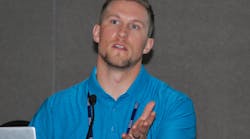With a name derived from the Latin word for “to help,” adjuvants are pharmaceutical substances that increase the intensity of immune response when administered with a vaccine or other medication. They can reduce the required vaccine dose, the number of injections and even increase stability of the vaccine itself. An unlikely source of such helpful medications is a campus nestled in the scenic Bitterroot Valley of western Montana, GlaxoSmithKline’s Hamilton facility—a figurative stone’s throw from the Chief Joseph Ranch featured in the popular Yellowstone TV series.
Here, Levi Merkel, automation engineering lead, is among the team working to ensure the safe and efficient production and isolation of such adjuvant compounds. He spoke this week at Emerson Exchange Immerse to share his experiences with digital twin technology commissioned in conjunction with the start-up of a new production unit in January 2023.
The unit hosts both DeltaV automation and safety instrumented systems (SIS) along with a range of “smart” and “dumb” skids—the former supplied with their own Rockwell Automation controllers and the latter fully controlled by the unit’s DeltaV system. “There are 1,200 DeltaV I/O points and another 400 on the smart skids,” Merkel explained. And because the process uses toxic acetonitrile as a solvent, the SIS provides essential protections.
What made the production unit somewhat unique on the Hamilton campus is the inclusion of an operator training simulator based on Emerson Mimic software. “Everything that the operator interacts with in the production unit is replicated in the simulator—it all looks, tastes and smells the same,” Merkel said. While the production system consists of a DeltaV console, redundant PK controllers and both smart and dumb skids, the OTS consists of a DeltaV console, simplex PK controller, the Mimic software as well as separate software to emulate the Rockwell Automation PLCs.
Merkel also thought it important to explain that the Mimic system as it’s currently deployed represents not so much a digital twin (although that’s the ultimate destination), but a digital model that supports increased process understanding. “It’s the lowest fidelity and lowest cost option,” Merkel explained, noting that there’s no automatic feedback of data from the production unit to the model.
He envisions that with continued investment they can move from a digital model into the realm of a “digital shadow” that better supports decision-making with automated data transfer from physical object to digital one, and ultimately to a digital twin, with closed-loop data transfer between physical and digital worlds—providing the highest fidelity model but at the highest cost, Merkel said.
Since the production unit in question was the first of its kind, a low fidelity model was deemed adequate, both because the process was not well enough understood to justify more upfront investment and because the process centers primarily around a chromatographic separation and does not entail more sensitive reaction kinetics.
Best laid plans
The original purpose of the Mimic system was two-fold. First, to provide an offline environment on which personnel could be trained. Second, to provide a platform on which process control code could be tested before being deployed on the production unit.
As things have turned out, the team has been so busy supporting production that most of the operator training has been done on the production unit itself. But the simulator has not been idle, instead earning its keep during commissioning and qualification and to test the effects of potential automation changes on unit performance.
For example, the simulator was used to verify the clean-in-place recipe for the column-packing skid, allowing development of the standard operating procedure (SOP) well ahead of schedule. It has also provided a platform to troubleshoot and test solutions to identified problems without interrupting production.
Time savings during the unit’s site acceptance test and commissioning activities added up to some 270 hours—from an estimated 400 hours on the production unit to 130 hours on the simulator. Also, some 50 issues were addressed at least in part on the simulator, substantially avoiding any significant impact on the production unit. “Time on the production unit has been at a premium since before start-up,” Merkel said.
In addition, the knowledge gained via the simulator has saved an estimated $144,000 in raw materials and another $552,000 in waste handling expenses—returning more than its entire cost, despite little time spent training operators as initially intended. But Merkel and the team have big plans both short and long term, to formalize the operator training originally envisioned, add the unit’s SIS to the model’s scope, increase its fidelity and ultimately close the synchronization between production unit and simulator to achieve the ultimate destination of a fully functional digital twin.



